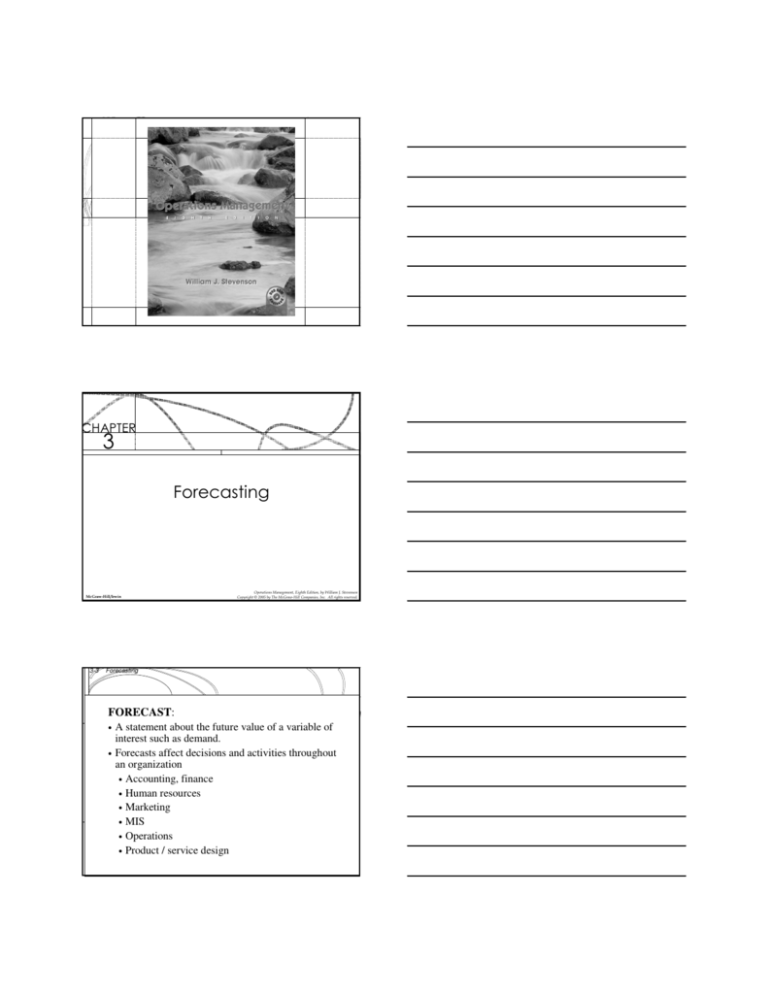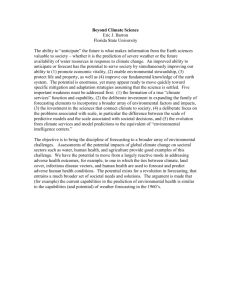
3-1
Forecasting
Operations Management
William J. Stevenson
8th edition
3-2
Forecasting
CHAPTER
3
Forecasting
McGraw-Hill/Irwin
3-3
Operations Management, Eighth Edition, by William J. Stevenson
Copyright © 2005 by The McGraw-Hill Companies, Inc. All rights reserved.
Forecasting
FORECAST:
•
•
A statement about the future value of a variable of
interest such as demand.
Forecasts affect decisions and activities throughout
an organization
• Accounting, finance
• Human resources
• Marketing
• MIS
• Operations
• Product / service design
3-4
Forecasting
Uses of Forecasts
3-5
3-6
Accounting
Cost/profit estimates
Finance
Cash flow and funding
Human Resources
Hiring/recruiting/training
Marketing
Pricing, promotion, strategy
MIS
IT/IS systems, services
Operations
Schedules, MRP, workloads
Product/service design
New products and services
Forecasting
•
Assumes causal system
past ==> future
•
Forecasts rarely perfect because of
randomness
•
Forecasts more accurate for
groups vs. individuals
•
Forecast accuracy decreases
as time horizon increases
I see that you will
get an A this semester.
Forecasting
Elements of a Good Forecast
Timely
Reliable
M
l
fu
ng
i
n
ea
Accurate
Written
sy
Ea
to
e
us
3-7
Forecasting
Steps in the Forecasting Process
“The forecast”
Step 6 Monitor the forecast
Step 5 Prepare the forecast
Step 4 Gather and analyze data
Step 3 Select a forecasting technique
Step 2 Establish a time horizon
Step 1 Determine purpose of forecast
3-8
Forecasting
Types of Forecasts
3-9
•
Judgmental - uses subjective inputs
•
Time series - uses historical data
assuming the future will be like the past
•
Associative models - uses explanatory
variables to predict the future
Forecasting
Judgmental Forecasts
•
Executive opinions
•
Sales force opinions
•
Consumer surveys
•
Outside opinion
• Delphi
method
•
Opinions of managers and staff
•
Achieves a consensus forecast
3-10 Forecasting
Time Series Forecasts
Trend - long-term movement in data
• Seasonality - short-term regular variations in
data
• Cycle – wavelike variations of more than one
year’s duration
• Irregular variations - caused by unusual
circumstances
• Random variations - caused by chance
•
3-11 Forecasting
Forecast Variations
Figure 3.1
Irregular
variation
Trend
Cycles
90
89
88
Seasonal variations
3-12 Forecasting
Naive Forecasts
Uh, give me a minute....
We sold 250 wheels last
week.... Now, next week
we should sell....
The forecast for any period equals
the previous period’s actual value.
3-13 Forecasting
Naïve Forecasts
Simple to use
Virtually no cost
• Quick and easy to prepare
• Data analysis is nonexistent
• Easily understandable
• Cannot provide high accuracy
• Can be a standard for accuracy
•
•
3-14 Forecasting
Uses for Naïve Forecasts
•
Stable time series data
•
F(t) = A(t-1)
•
Seasonal variations
•
Data with trends
•
•
F(t) = A(t-n)
F(t) = A(t-1) + (A(t-1) – A(t-2))
3-15 Forecasting
Techniques for Averaging
•
Moving average
•
Weighted moving average
•
Exponential smoothing
3-16 Forecasting
Moving Averages
•
Moving average – A technique that averages a
number of recent actual values, updated as new
values become available.
n
Ai
∑
i=1
MAn =
•
n
Weighted moving average – More recent values in a
series are given more weight in computing the
forecast.
3-17 Forecasting
Simple Moving Average
Actual
47
45
MA5
43
41
39
37
35
MA3
1
2
3
4
5
6
7
8
9
10 11 12
n
MAn =
Ai
∑
i=1
n
3-18 Forecasting
Exponential Smoothing
Ft = Ft-1 + α(At-1 - Ft-1)
• Premise--The most recent observations might
have the highest predictive value.
•
Therefore, we should give more weight to the
more recent time periods when forecasting.
3-19 Forecasting
Exponential Smoothing
Ft = Ft-1 + α(At-1 - Ft-1)
Weighted averaging method based on previous
forecast plus a percentage of the forecast error
• A-F is the error term, α is the % feedback
•
3-20 Forecasting
Example 3 - Exponential Smoothing
Period
Actual
1
2
3
4
5
6
7
8
9
10
11
12
Alpha = 0.1 Error
42
40
43
40
41
39
46
44
45
38
40
42
41.8
41.92
41.73
41.66
41.39
41.85
42.07
42.36
41.92
41.73
Alpha = 0.4 Error
-2.00
1.20
-1.92
-0.73
-2.66
4.61
2.15
2.93
-4.36
-1.92
42
41.2
41.92
41.15
41.09
40.25
42.55
43.13
43.88
41.53
40.92
-2
1.8
-1.92
-0.15
-2.09
5.75
1.45
1.87
-5.88
-1.53
3-21 Forecasting
Picking a Smoothing Constant
Actual
50
Dem and
α = .4
α = .1
45
40
35
1
2
3
4
5
6
7
Period
8
9 10 11 12
3-22 Forecasting
Common Nonlinear Trends
Figure 3.5
Parabolic
Exponential
Growth
3-23 Forecasting
Linear Trend Equation
Ft
Ft = a + bt
•
•
•
•
0 1 2
Ft = Forecast for period t
t = Specified number of time periods
a = Value of Ft at t = 0
b = Slope of the line
3 4 5
3-24 Forecasting
Calculating a and b
b =
n ∑ (ty) - ∑ t ∑ y
n∑ t 2 - ( ∑ t) 2
a =
∑ y - b∑ t
n
t
3-25 Forecasting
Linear Trend Equation Example
t
Week
1
2
3
4
5
2
t
1
4
9
16
25
2
Σ t = 15
Σ t = 55
2
(Σ t) = 225
y
Sales
150
157
162
166
177
ty
150
314
486
664
885
Σ y = 812 Σ ty = 2499
3-26 Forecasting
Linear Trend Calculation
b =
5 (2499) - 15(812)
12495-12180
=
= 6.3
5(55) - 225
275 -225
a =
812 - 6.3(15)
= 143.5
5
y = 143.5 + 6.3t
3-27 Forecasting
Associative Forecasting
•
Predictor variables - used to predict values of
variable interest
•
Regression - technique for fitting a line to a set
of points
•
Least squares line - minimizes sum of squared
deviations around the line
3-28 Forecasting
Linear Model Seems Reasonable
X
7
2
6
4
14
15
16
12
14
20
15
7
Y
15
10
13
15
25
27
24
20
27
44
34
17
Computed
relationship
50
40
30
20
10
0
0
5
10
15
20
25
A straight line is fitted to a set of sample points.
3-29 Forecasting
Forecast Accuracy
•
Error - difference between actual value and predicted
value
•
Mean Absolute Deviation (MAD)
•
•
Mean Squared Error (MSE)
•
•
Average absolute error
Average of squared error
Mean Absolute Percent Error (MAPE)
•
Average absolute percent error
3-30 Forecasting
MAD, MSE, and MAPE
MAD
=
∑ Actual
− forecast
n
MSE
=
∑ ( Actual
− forecast)
2
n -1
MAPE =
∑( Actual
− forecast / Actual*100)
n
3-31 Forecasting
Example 10
Period
1
2
3
4
5
6
7
8
Actual
217
213
216
210
213
219
216
212
Forecast
215
216
215
214
211
214
217
216
(A-F)
2
-3
1
-4
2
5
-1
-4
-2
|A-F|
2
3
1
4
2
5
1
4
22
(A-F)^2
4
9
1
16
4
25
1
16
76
(|A-F|/Actual)*100
0.92
1.41
0.46
1.90
0.94
2.28
0.46
1.89
10.26
2.75
10.86
1.28
MAD=
MSE=
MAPE=
3-32 Forecasting
Controlling the Forecast
•
Control chart
•
•
•
A visual tool for monitoring forecast errors
Used to detect non-randomness in errors
Forecasting errors are in control if
All errors are within the control limits
• No patterns, such as trends or cycles, are
present
•
3-33 Forecasting
Sources of Forecast errors
Model may be inadequate
Irregular variations
• Incorrect use of forecasting technique
•
•
3-34 Forecasting
Tracking Signal
•Tracking signal
–Ratio of cumulative error to MAD
Tracking signal =
∑(Actual-forecast)
MAD
Bias – Persistent tendency for forecasts to be
Greater or less than actual values.
3-35 Forecasting
Choosing a Forecasting Technique
•
•
No single technique works in every situation
Two most important factors
•
•
•
Cost
Accuracy
Other factors include the availability of:
Historical data
Computers
• Time needed to gather and analyze the data
• Forecast horizon
•
•
3-36 Forecasting
Exponential Smoothing
3-37 Forecasting
Linear Trend Equation
3-38 Forecasting
Simple Linear Regression
3-39 Forecasting
Workload/Scheduling
SSU9
United Airlines example









